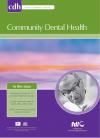Community Dental Health

- Cover Date:
- June 2008
- Print ISSN:
- 0265 539X
- Vol:
- 25
- Issue:
- 2
Short Communication - Orthodontic treatment need in Nigerian children
Objective The purpose of this study was to assess the need for orthodontic treatment among Nigerian children aged 12-14 years old in Benin City, south-southern region of Nigeria. Research Design The sample consisted of 261 randomly selected school children, 122 boys (47%) and 139 girls (53%) with mean age of 12.9 ± 0.1. The survey was conducted by clinical examination and both components of the Index of Orthodontic Treatment Need (IOTN) were used to determine the need for orthodontic treatment. Results The results revealed that 50 (19.2%) of the children had a definite need for orthodontic treatment according to dental health component while aesthetic component of IOTN indicated definite need in 12 (4.6%). Increased overjet, severe contact displacements and impeded eruption of teeth were the common occlusal features in the definite treatment need group. Conclusion This study provided data on the need for orthodontic treatment among Nigerian school children which is useful to plan and prioritise orthodontic care and services.
Key words: Index of Orthodontic treatment need, malocclusion, Nigerian children, orthodontic treatment need.
- Article Price
- £15.00
- Institution Article Price
- £
- Page Start
- 126
- Page End
- 128
- Authors
- E.O. Ajayi
Articles from this issue
- Title
- Pg. Start
- Pg. End
- Editotial - Do we let children’s teeth decay just because some people object to topping up the natural fluoride that’s already in our water?
- 66
- 69
- Dental caries rates in primary teeth in 2002, and caries surveillance trends 1981-2002, in a South African city.
- 79
- 83
- Individual and maternal determinants of self–reported dental health among Turkish school children aged 10-12 years.
- 84
- 88
- Comparison of ranking dental status using the Significant Caries Index and the Significant Filled and Sound-Teeth Index
- 103
- 106
- Measuring oral health behaviour in Flemish health care workers: an application of the Theory of Planned Behaviour
- 107
- 114
